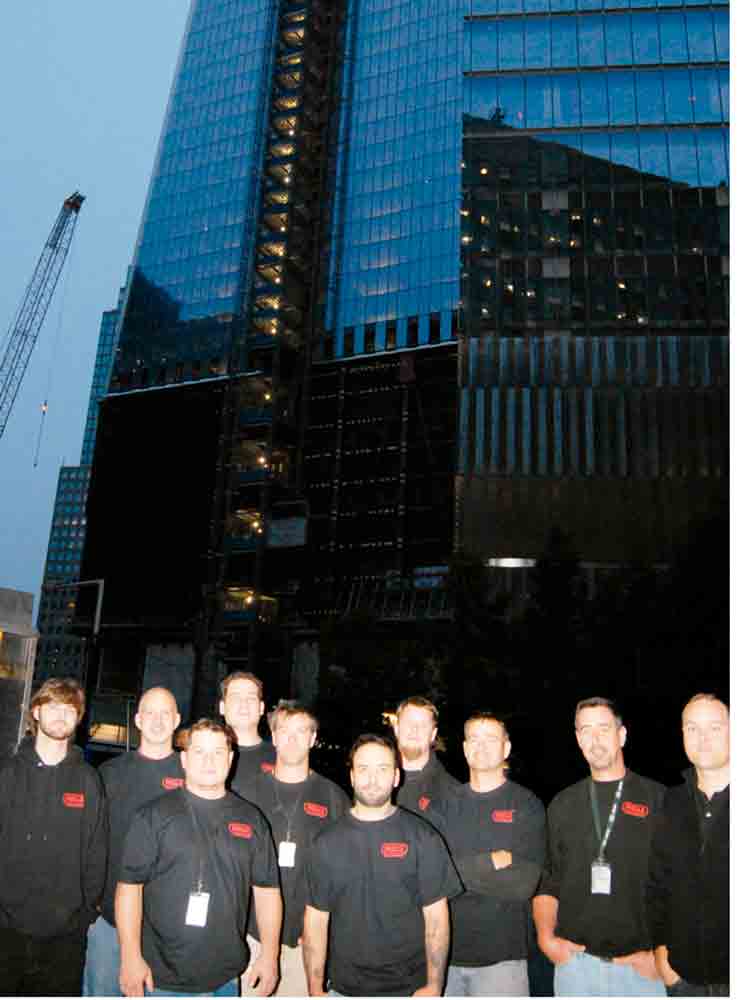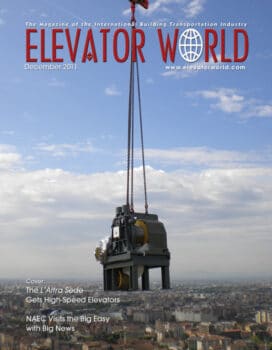ABB, Baldor Announce Single Sales Force
Dec 1, 2011

In October, ABB and Baldor Electric Co. announced a single U.S. sales force to sell and support their line of low- and medium-voltage industrial drives and industrial electric motors. The companies believe customers will gain many benefits from the transition, including a single point of contact, 24-hour local sales and service, a wide range of drives and motors available from one source, and a full line of products for energy-efficient motor-driven systems. Aaron Aleithe, vice president and general manager of Low Voltage Drives for ABB U.S., expects the transition to make buying industrial motors and drives easier for customers, while providing them with a high level of customer service. Ron Tucker, CEO and president of Baldor, stated:
“ABB and Baldor both have a long history of manufac-turing industrial electric motors and drives. Together, we believe we can take better care of our industrial customers than anyone else.”
ABB is a leader in power and automation technologies that provide improved performance, while lessening en-vironmental impact. Baldor, a member of The ABB Group, is a marketer, designer and manufacturer of industrial electric motors, mechanical power-transmission products, drives and generators.
Thyssenkrupp Elevator Receives Ul Validation
ThyssenKrupp Elevator Americas’ standard line of U.S. elevator cabs has been validated by Underwriters Labo-ratories Inc. (UL) Environment for low volatile-organic-compound emitting material in its cabs per California’s Section 01350. An audit was performed to test the indoor air quality of the cabs. The validation process is a step toward a “green” product line.
Brad Nemeth, director of sustainability for ThyssenKrupp Elevator, said:
“Our company has taken a significant step towards evaluating and reducing the impact of our building materials on the indoor air quality of our standard elevator cabs. We hope this validation process becomes a major driving force behind the entire industry creating more environ-mentally friendly products and overall healthier buildings.”
Schindler Port Technology In Raleigh
The 14-story Capital Bank Plaza in Raleigh, North Carolina, was equipped with Schindler’s Personal Occupant Requirement Technology (PORT)(ELEVATOR WORLD, January 2011) in August, making it one of the first buildings to receive such technology in the state. The elevator technology helps move building occupants more efficiently by functioning as a two-way communication in-terface between the occupants and the building’s environ-ment. PORT features an access control system capable of cal-culating the optimum route to any destination within the building, in addition to “learn-ing” how occupants typically move around.
Rezoning Proposal Includes High Rises
McLean Commons in McLean, Virginia, would become a high-rise apartment community under a rezoning pro-posal filed with Fairfax County. Under the proposal, the area’s 12 two-story apartment buildings containing 331 units would be replaced by seven high-rise buildings ranging in height from 18-24 stories and containing 2,504 units. According to developers, the expansion will make the Commons part of a larger mixed-use neighborhood centered around four new metro stations scheduled to open in 2013 and help transform the area from suburb to city. Plans include a connected street network, additions to local parks, “innovative” storm-water management, sustainable buildings and workforce housing. As of October, the proposal had yet to be approved, with revisions from the community and county expected.
Peelle Works On WTC Rebuilding
The Peelle Co. has been busy working on a variety of projects with multiple contractors at the World Trade Center (WTC) site in New York City. At the WTC Museum, Peelle provided its new Horizontal Sliding Doors for a passenger/freight application, as well as a vertical bi-parting door system for the museum that memorializes 9/11 and the WTC.
One of the first buildings completed at the site was WTC Tower 7, where Peelle provided vertical bi-parting doors. This structure is now occupied by New York state and New York City governments. For WTC Tower 1 (Freedom Tower), Peelle is installing over 1,100 passenger-elevator doors from National, and at WTC Tower 4, Peelle is installing 637 Schindler/Columbia passenger elevator doors. The Transportation Hub and the WTC Security Center will also include freight elevators with vertical bi-parting doors furnished and installed by Peelle.
Devon Tower Reaches Peak
The Devon Tower in downtown Oklahoma City reached its peak ahead of schedule and under budget in September. Construction workers celebrated the topping out of the 50-story tower by planting an evergreen tree at the building’s highest point. To be completed in early 2013, the tower will house Devon Energy, which expects to start moving in by March 2012. The US$750-million tower will be equipped with 50 elevators and LEDs at the building’s three corners to light up the building with colors appropriate for particular seasons, holidays, etc.
Harvard To Finish Allston Development
Harvard University’s Executive Vice-President Katherine Lapp announced in September that plans are underway for the completion of the school’s US$1-billion Health and Life Science Center in Allston, Massachusetts. It has been approximately two years since construction of the project came to a halt due to the global financial crisis, which necessitated a shift away from rapid development in Allston. The building plan will be evaluated and repro-grammed to ensure the optimization of science and re-search space. The center is to serve as an important component of the university’s upcoming capital campaign. Lapp expects to share the proposed changes with the Boston Redevelopment Authority and the community by June. Additionally, the school is planning to develop rental housing for graduate students, faculty members and vis-iting scholars in the Barry’s Corner section of Allston.
Janus to Separate Businesses
The Janus Elevator Products, Inc. board of directors unanimously approved a recent separation of the company’s two businesses – Janus and Monitor Controls. Effective October 1, Janus continues as an independent company focused on its safety edge, emergency phone and digital-display components, while Monitor Controls focuses on elevator fixtures and touch-panel displays. This transition will allow each business to operate independently to more effectively serve its customers. Rob Isabelle, former vice president of engineering and manufacturing, will lead Monitor Controls as president, and Mike Byrne will continue as president of Janus. In addition, Monitor Con-trols will join Janus in Halma p.l.c.’s elevator division, along with TL Jones, Memco and E-Motive.
Thyssenkrupp Elevator Acquires United
ThyssenKrupp Elevator has acquired the assets of United Elevator Co., Inc. of Philadelphia, which focused on elevator maintenance, repair and moderniza-tion for more than 50 years. In addi-tion to its corporate office in Philadel-phia, United Elevator has branches in Atlantic City and Wilmington, Delaware. The acquisition is in line with ThyssenKrupp AG’s development plan to expand its technology business. ThyssenKrupp Elevator also recently announced the acquisition of General Elevator Sales and Service of Florida (ELEVATOR WORLD, November 2011).
NFPA Affiliate, Nist Research Agenda
The Fire Protection Research Foun-dation, an affiliate of the National Fire Protection Association (NFPA), is working with the National Institute of Standards and Technology (NIST) to develop a prioritized agenda for a new fire-resistance testing facility which is scheduled for completion in 2012. The center is part of the Engineering Research Laboratory and will be able to test large scale structural elements, sys-tems and their connections in the fire condition.
Also, NIST recently held a workshop in Gaithersburg, Maryland, in an effort to gather information and develop the agenda. Forty representatives from academia, engi-neering and the materials industry provided their perspec-tives on the agenda, which is scheduled for completion this month.
August Construction Increase
According to McGraw-Hill Con-struction, a division of The McGraw-Hill Companies, new construction starts in August increased by 8%. The gain followed a 10% decline in July. An August increase in total construction was the result of greater activity for each of the three main sectors – nonres-idential, residential and nonbuilding construction. For the first eight months of 2011, total construction was report-edly down 6% from the same time in 2010.
During the first five months of 2011, construction trended downward, but an up-and-down pattern emerged, sug-gesting that construction starts were beginning to stabilize after an earlier loss of momentum. Total construction as a whole is on track to register a moderate decline for 2011, after level-ing off in 2010. While August showed some improvement for institutional building and public works, these sec-tors will see funding cutbacks by the state and federal government. What appears to be early signs of recovery for commercial building may be deferred by rising investor concern over employment growth and the short-term prospects of the U.S. economy.
In August, nonresidential building grew 7%, while the institutional side of the nonresidential market jumped by 107%. The public-building category climbed 55% from July, and the amuse-ment-related category increased 18%.
Educational building fell 7%, along with transportation terminals, which were down 8%.
The commercial side of the nonresidential market showed a mixed pattern by project type. Hotel construction increased 125% from July, while warehouse construction grew 30%, and store construction advanced 18%. Both office construction and the manufacturing building category fell by 18% and 62%, respectively.
Residential building was up by 4% in August, with a majority of the upward movement coming from multi-family housing, which rose 15%. Through the first eight months of 2011, the top five metropolitan areas in terms of the cost of multifamily projects were New York City; Washington, D.C.; Boston; Chicago; and Los Angeles.
Nonbuilding construction was up 13%. Dams and river/harbor development surged 283%, with sewer and waste disposal advancing by 64%. However, other types of public works fell, including a 21% drop for highways and bridges. A decline of 8% was also reported for miscellaneous public works, though the electric utility category strengthened by 18%.
The 6% shortfall for total construction on an unadjusted basis during January-August reflected a mixed performance by sector. By region, total construction starts showed the following year-to-date performance – Midwest and Northeast, down 13% each; South Atlantic, down 6%; South Central, down 4%; and West, up 4%.
Get more of Elevator World. Sign up for our free e-newsletter.









